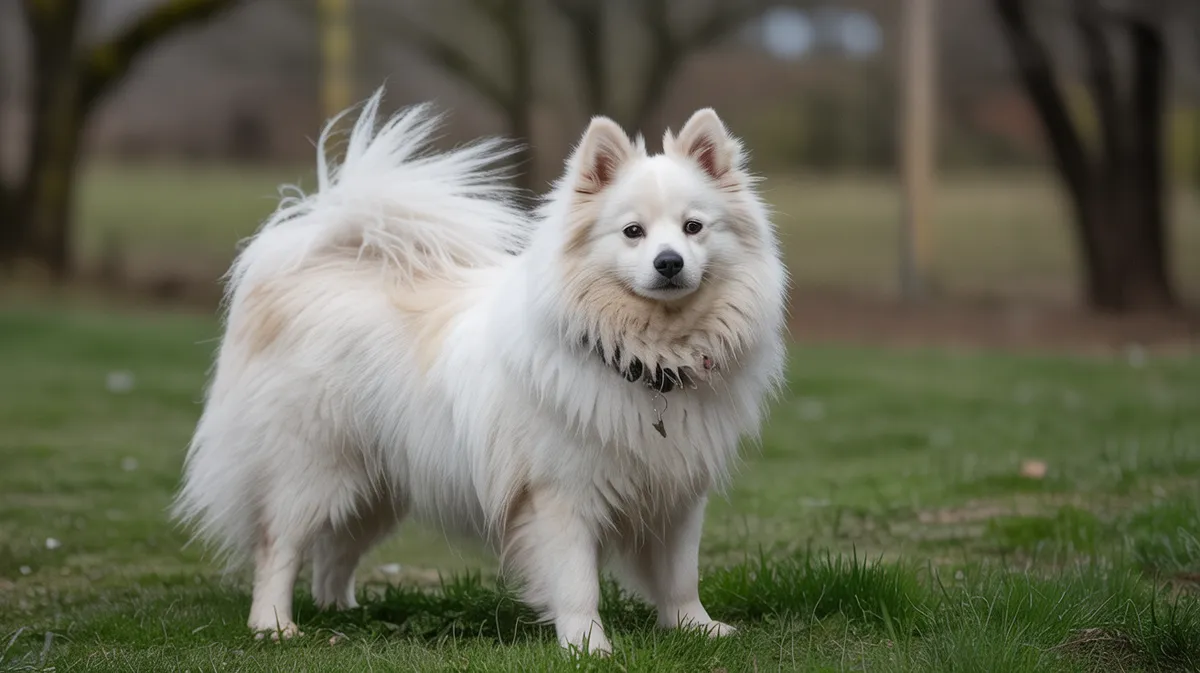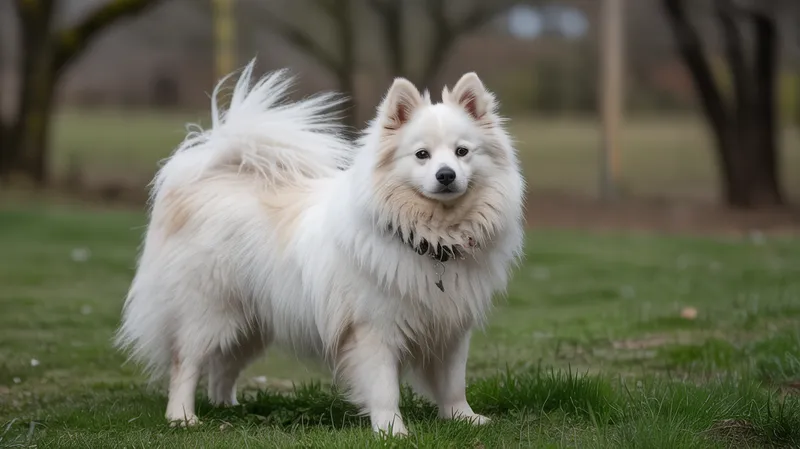
American Eskimo Dog
Canis lupus familiaris

Meet the American Eskimo Dog
The American Eskimo Dog is a strikingly beautiful companion breed known for its white, fluffy double coat, erect ears, and expressive dark eyes. Despite its name, the breed was developed in the United States and is a member of the Spitz family, closely related to the German Spitz. Energetic, highly intelligent, and eager to please, American Eskimo Dogs excel at obedience, agility, and performing tricks. They are affectionate and loyal, making them excellent family pets, but they require regular exercise and mental stimulation to thrive.
Classification
Mammal
Habitat
Domestic, suburban and urban environments
Diet
Omnivore
Lifespan
12-15 years
Conservation
Least Concern
Weight
6-16 kg (13-35 lbs), depending on size variety
📖Fascinating Facts
Circus Star
American Eskimo Dogs were famous circus dogs, renowned for their ability to perform complex tricks and even walk tightropes.
Three Size Varieties
The breed comes in three sizes: Toy, Miniature, and Standard, making them suitable for a variety of homes and lifestyles.
Not from the Arctic
Despite their name, American Eskimo Dogs do not originate from the Arctic or have any historical connection to Eskimo peoples.
📋Detailed Description
The American Eskimo Dog is a compact, well-balanced member of the Spitz family, characterized by its dense, weather-resistant double coat, which is always white or white with biscuit cream markings. The breed comes in three size varieties: Toy (23–30 cm/9–12 in at the shoulder), Miniature (30–38 cm/12–15 in), and Standard (38–48 cm/15–19 in), with weights ranging from 2.7–16 kg (6–35 lbs) depending on size. The head is wedge-shaped with a slightly domed skull, erect triangular ears, and a pronounced ruff around the neck and chest. The tail is heavily plumed and carried over the back. American Eskimo Dogs are known for their keen intelligence, alertness, and agility, traits that made them popular as circus performers in the early 20th century. They have a lively, expressive face with dark, almond-shaped eyes and a black nose and lips. Their thick undercoat provides insulation, while the longer outer coat repels moisture and dirt. This breed is highly social, forming strong bonds with family members and displaying a protective, sometimes vocal, nature. They are quick learners, excelling in obedience and agility sports, and require regular mental and physical stimulation to prevent boredom-related behaviors. Their lifespan typically ranges from 12 to 15 years, with some individuals living longer with proper care.
💡 Did you know?
The breed was originally called the 'American Spitz' but was renamed during World War I due to anti-German sentiment.
🔬Research & Sources
Wikipedia Summary
The American Eskimo Dog is a breed of companion dog, originating in Germany. The American Eskimo Dog is a member of the Spitz family. The breed's progenitors were German Spitz, but due to anti-German sentiment during the First World War, it was renamed "American Eskimo Dog." Although modern American Eskimo Dogs have been exported as German Spitz Gross, the breeds have diverged and the standards are significantly different. In addition to serving as a watchdog and companion, the American Eskimo Dog also achieved a high degree of popularity in the United States in the 1930s and 1940s as a circus performer.
Last Modified: 4/20/2025
🎭Behavior & Social Structure
American Eskimo Dogs are highly intelligent and energetic, displaying a strong desire to interact with their human families. They are known for their alertness and tendency to bark, making them effective watchdogs. While not aggressive, they can be reserved or cautious with strangers, often alerting their owners to unfamiliar people or sounds. Socialization from an early age is important to prevent excessive shyness or suspicion. They thrive on routine and enjoy structured activities such as obedience training, agility, and learning tricks. Their play behavior is lively and interactive, often involving fetch, chase, or puzzle toys. As omnivores, their feeding behavior is typical of domestic dogs, with a preference for high-quality commercial or home-prepared diets. They do not exhibit hunting behavior but may have a moderate prey drive toward small animals. Daily routines should include ample exercise, mental stimulation, and social interaction to prevent the development of problem behaviors such as destructiveness or excessive vocalization.
👶Reproduction & Life Cycle
American Eskimo Dogs reach sexual maturity between 6 and 12 months of age, with females typically coming into estrus twice a year. The breed does not have a specific breeding season, as domestic dogs are capable of breeding year-round. Gestation lasts approximately 63 days. Litter sizes range from 3 to 5 puppies, though larger litters are possible in Standard-sized individuals. Parental care is primarily provided by the dam, who nurses and cleans the puppies for the first three to four weeks. Puppies are born blind and deaf, opening their eyes around two weeks of age. Weaning begins at about four weeks, with puppies gradually transitioning to solid food. Responsible breeders emphasize genetic health screening and early socialization to ensure well-adjusted, healthy offspring.
🛡️Adaptations & Survival
The American Eskimo Dog's dense double coat is a key adaptation to cold climates, providing both insulation and protection from moisture. The outer guard hairs repel snow and rain, while the soft undercoat traps air for warmth. Their compact, muscular build and well-feathered tail help conserve body heat. The breed's high intelligence and trainability are behavioral adaptations that have facilitated their roles as companions, performers, and watchdogs. Their keen senses of hearing and smell, along with their alert disposition, make them highly responsive to environmental changes. The breed's social nature and strong attachment to humans are evolutionary specializations resulting from centuries of selective breeding for companionship and cooperation.
📚Research Sources
🎨Cultural Significance
The American Eskimo Dog holds a unique place in American cultural history, particularly as a popular circus performer during the 1930s and 1940s. Their intelligence, agility, and striking appearance made them favorites for performing complex tricks and routines, helping to popularize the breed nationwide. Despite the misleading name, the breed has no historical connection to Eskimo or Inuit cultures; the name was adopted during World War I due to anti-German sentiment. The American Eskimo Dog is often associated with loyalty, cleverness, and beauty in popular culture, and remains a beloved companion and family pet. The breed is also recognized for its role in therapy and assistance work, owing to its trainability and gentle disposition.
🔬Recent Research & Discoveries
Recent genetic studies have clarified the American Eskimo Dog's close relationship to the German Spitz and other European Spitz breeds, with divergence occurring primarily due to selective breeding in the United States. Ongoing research focuses on identifying genetic markers for inherited diseases common in the breed, such as progressive retinal atrophy and hip dysplasia, to improve breeding practices. Behavioral studies have highlighted the breed's exceptional problem-solving abilities and responsiveness to positive reinforcement training. There is also growing interest in the breed's suitability for canine-assisted therapy and service work, with preliminary studies indicating high success rates in these roles.
🎥Wildlife Videos

Man's First Friend - The Epic Story of Dogs & Humans | Free Documentary Nature
Man's First Friend - Ths History of Dogs & Humans | Nature Documentary Watch 'Wildlife - Just Wild Dogs' here: ...
Free Documentary - Nature

Wildlife - Just Wild Dogs | Free Documentary Nature
Wildlife - Episode 7: Just Wild Dogs | Wildlife Documentary Watch 'Wildlife - Episode 8' here: https://youtu.be/kglJpB4ei8o Run ...
Free Documentary - Nature

THE LAST DOGS OF WINTER Trailer
For the past 40 years, in a remote and harshly beautiful corner of northern Manitoba, Brian Ladoon has devoted his life to ...
NZ International Film Festival

short documentary on American Eskimo dog 🐶🐕 #animals #wildlife
Animal Planet 148

The Incredible Life Of A Sled Dog (Wildlife Documentary) | Natural Kingdom | Real Wild
This is the story of an icon, the Canadian Inuit Dog; from ancient roots in the Arctic as the working sled dog of the Inuit to its ...
Real Wild

American Eskimo Dog | Cute Eskimos American Dogs
Check out these Breeds of Eskimos.. Do American Eskimo Dog Bark? Yes they Do and also When they are bored they tends to ...
Animal Planet - World II
🌍Habitat Information
The American Eskimo Dog typically inhabits Domestic, suburban and urban environments environments. American Eskimo Dogs have adapted to their environments with specialized features and behaviors.
Primary Habitat:
Domestic, suburban and urban environments
More detailed habitat information will be available soon.
🛡️Conservation Status
The American Eskimo Dog is currently classified as Least Concern. Conservation efforts are crucial for preserving this species for future generations.
Common Threats:
- 🏠Habitat loss and fragmentation
- 🌡️Climate change impacts
- 🎯Hunting and poaching
- 🏭Human-wildlife conflict
⚠️Threats & Conservation Challenges
As a domestic breed, the American Eskimo Dog faces few natural threats. However, irresponsible breeding practices can lead to inherited health problems such as hip dysplasia, progressive retinal atrophy, and patellar luxation. Obesity is a common challenge due to their small to medium size and tendency to gain weight if under-exercised. Behavioral issues such as separation anxiety, excessive barking, and destructiveness may arise if their mental and physical needs are not met. The breed is not considered at risk in terms of population, and its conservation status is 'Least Concern.' However, maintaining genetic diversity and promoting responsible ownership are ongoing challenges within the breed community.
🔬Scientific Classification
Scientific Name
Canis lupus familiaris
Classification Hierarchy
🔍 About Taxonomic Classification
Taxonomic classification is a hierarchical system used by scientists to classify and organize living organisms based on shared characteristics and evolutionary relationships.
The system moves from broad categories (Kingdom) to increasingly specific ones, with each animal's scientific name typically consisting of its Genus and species.
📝Community Notes
Share your observations and insights about the American Eskimo Dog with our community of wildlife enthusiasts.
Join Our Community
Sign in to share your observations and connect with fellow wildlife enthusiasts.
Sign In to ContributeNo community notes yet
Be the first to share your observations about the American Eskimo Dog!
Explore American Eskimo Dog
Select a tab above to learn more about this amazing animal.
📸Photo Gallery
No photos available for this animal yet.
🌟Discover More Wildlife
Continue your journey of discovery with more fascinating animals from our database
